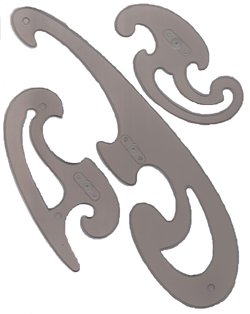 As an art student, Allyson is asked to do projects that require her to learn new tools and techniques. For a recent project in her technical drawing class, the instructor demonstrated how to use french curves to achieve perfect curves. After several disastrous attempts to work with the french curves, Allyson finally reverted to drawing curves freehand in order to get the project finished on time.
As an art student, Allyson is asked to do projects that require her to learn new tools and techniques. For a recent project in her technical drawing class, the instructor demonstrated how to use french curves to achieve perfect curves. After several disastrous attempts to work with the french curves, Allyson finally reverted to drawing curves freehand in order to get the project finished on time.
Here’s her take on trying to learn the french curves tool:
- Hard to master. The ink kept creating dots whenever she’d start or end a curve.
- Didn’t seem to be as useful for small scale curves. Might work well drawing large curves where it’s harder to keep a steady hand.
- Much easier to draw curves by hand.
Having never successfully used the french curves she acquired in art school herself, Bethany was curious about french curves and how they are used today (if at all). After some time on the web and chatting with her designer friends, she found that most folks either did not know how to use french curves at all (many had them tucked away in a drawer since art school) or chose to either draw curves by hand or on the computer. Interestingly enough, her friends who sew or do wood working were the only ones who still used french curves regularly. Perhaps engineers and architects still use them as well?
Here are some interesting things Bethany found while researching french curves:
- Instructions with illustration on how to use a french curve (looks like it’s from a textbook)
- How to use a french curve for sewing (general suggestions)
- Using French Curves and Circle Templates with Wacom Cintiq (combining hand tools with the computer)
- French Curves and Watercolor Flowers (student art project with lovely pics)
- French Curves, Sharpies and Patience (amazing art done with french curves)
